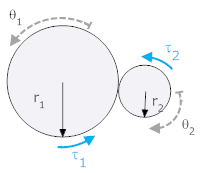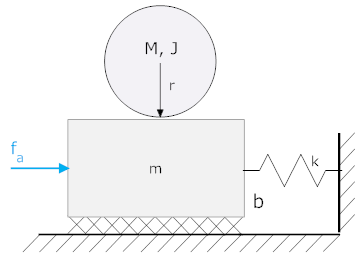How Can You Make Gear a and D Rotate in the Same Direction
Gears and Systems with both Rotation and Translation
Contents
- Gears
- Pulleys
- Systems that both rotate and interpret
Gears
Gears perform many functions, in this section we await at gears that increase or reduce athwart velocity (while simultaneously decreasing or increasing torque, such that energy is conserved). In many means gears deed in rotating systems as do levers in translating systems. A picture of gears is shown beneath, along with a schematic representation.


photograph from: http://www.geardesign.co.uk/spur-gears.htm
Nosotros volition specify gears by their radii. When you buy gears you normally specify the number of teeth and the number of teeth per inch (or centimeter). These two measures are equivalent: the number of teeth and teeth per inch give the circumference, which in turn determines the radius. If the number of teeth are doubled, the radius is doubled.
If we consider two gears in equilibrium and in contact with each other, we can two very useful relationships.

Starting time we annotation the geometric human relationship that results from the path that the arc lengths along their circumference must be equal as the gears turn.

Since the arc lengths (shown with a heavy blue line) must exist equal
roneθ1 = rtwoθ2 = arc length
If we had defined θ2 in the opposite direction, this expression would accept a negative sign (r1θ1 = -r2θ2).
We derive a second relationship from a torque rest. Earlier nosotros tin can do and so we must ascertain a force between the gears termed a "contact force." This force must be equal and opposite across the interface between the two gears, but its management is arbitrary. We showtime by drawing free torso diagrams with a contact strength where the gears meet.

The contact force is tangent to both gears and then produces a torque that is equal to the radius times the strength.

We can do a torque residuum on each of the ii gears
We are not usually interested in fc, and so nosotros remove from the equations and nosotros get

It is easy to show that the aforementioned relationship exists even if the contact forces are defined in the contrary direction (up on gear 1, down on gear two).
Example: Equations of motion for a system with gears
In the system below, a torque, τ a, is practical to gear ane (with moment of inertia J1). It, in turn, is connected to gear two (with moment of inertia J2) and a rotational friction Br. The angle θone is defined positive clockwise, θ2 is defined positive clockwise. The torque acts in the management of θ1.
Derive a differential equation for the system below in terms of θane (i.eastward., θ2 and fc should not exist in the final result).

Nosotros outset by cartoon costless torso diagrams, including a contact force that we volition arbitrarily choose to be downwardly on Jone and up on Jtwo. The directions of the reaction forces due to inertia and friction are chosen, every bit always, opposite to the defined positive management.

We convert the force to a torque (note: we could have skipped the previous stride and done this directly)

This yields the two equations of motion

We can hands solve for fc and eliminate it from the equations, but nosotros also need to eliminate θ2. To exercise this we use the human relationship betwixt θ1 and θii (from equal arc lengths).
r1θ1 = -riiθ2
Annotation that nosotros have a negative sign here because of the way θane and θ2 were defined (if θi moves in the positive direction, then θ2 is negative). When you lot employ the arc length expression y'all must exist conscientious of signs.

We can put this into the equation for J1 and solve (in standard class with the output (θi) on the left, and the input (τ a) on the right.

Notation: the same upshot is obtained independent of the chosen direction for θii and fc.
The final result from the example is important deserves some detect. The multiplication of J2 and Br by the square of the ratio of the radii is a well known, and full general phenomenon. If a load is fastened to a system through gears, the perceived consequence is multiplied by the square of the ratio of the radii. We can use this to our reward to make a load announced smaller (if we accept a weak driving torque - for instance, a small motor). The reason bicycles have gears is and then that the load perceived by the bicycle rider can be kept relatively constant even as due south/he goes upwards or down hills.
Aside: Conservation of power in gear trains.
Note that if nosotros combine the geometric relationship

with the torque human relationship,

the production of torque and velocity becomes:

You lot will encounter on the next spider web page that the product of angular velocity and torque is power. Then the terminal equation simply states that power is preserved beyond a ready of gears. The gears permit one to trade torque for athwart velocity (i.east., if the gears are of unequal size, the larger gear will experience college torque but lower angular velocity than the smaller gear).
Pulleys
While this document doesn't discuss pulleys directly, the concepts are closely related (i.e., you must perform a torque balance around the pivot). Pulleys are discussed here.
Rotation and Translation
Systems that have parts that rotate and interpret are handled in much the same manner equally with gears:
- Define relationships betwixt rotation and position (i.eastward., relate arc length of translating elements to angle of rotating elements)
- Ascertain a contact force between moving objects.
- Subsequently those steps are achieved, all that is needed is to draw free trunk diagrams. The only difference here is that if an element both translates and rotates, that 2 complimentary trunk diagrams are needed for that element: one that rotates, and one that translates, just these motions can exist considered independently.
The process will exist illustrated with an instance.
Instance: Elements that rotate and interpret
Derive equations of motility for the system shown along with an expression relating horizontal position to angle of rotation. There is a force, fa, practical to a mass m. A uniform cylinder sits on top of the mass and is gratis to coil and interpret, just it rolls without slipping.

First we demand to ascertain positions, in this example three of them. We need to define one for the position of the mass, m, and i for the angle through which the cylinder has turned about its center. We also need to define one for the lateral position of the cylinder.

At present we can depict costless body diagrams (again, we need three), and write the equations of motion. Hither we have taken fc to exist to the correct on grand, and to the left on the cylinder. Torques are taken about the center of mass.
The final thing nosotros need is a relationship between position and arc length for the cylinder. In this case information technology is not then obvious, but is easily found with a little thought.
- If xane changes while x2 remains constant, then r·θ=x1
- If x2 changes while x1 remains constant, and then r·θ=-x2
Therefore, by superposition
r·θ=ten1-xtwo
Key Concept: Solving bug involving gears and/or systems that rotate and translate
When solving problems with gears, you e'er need to include two facts:
- Chronicle arc lengths (for gears r1θone = riiθtwo; for rotation and translation use rθ=x).
- There is a contact strength (equal and opposite) across the interface.
If y'all are not using both of these relationships, you probably won't be able to solve the trouble.
The motility of an body can exist separated into 2 independent component, translation and rotation. If an element both rotates and translates a dissever freebody diagram is needed for each component.
References
Supercede
DOWNLOAD HERE
How Can You Make Gear a and D Rotate in the Same Direction UPDATED
Posted by: scottyousand.blogspot.com